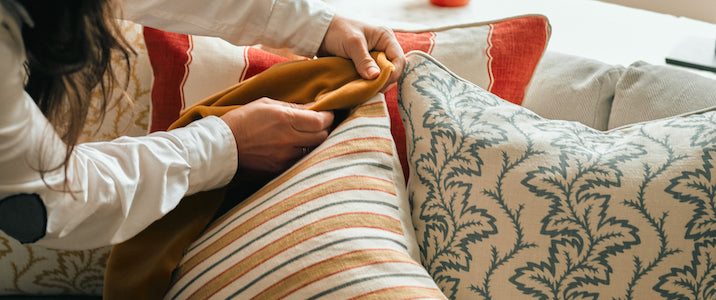

“In the process of creating a moodboard for the quilts, I discovered a drawing I had made of a bridge reflected in a river, and everything flowed from there.”
I took inspiration from paintings, collages and drawings and pulled together references to create the concept drawings.
.I don’t have the work of other artists visible in my studio space; I like to keep external references stored on heavily laden bookshelves and piles of exhibition postcards that adorn my desk to ensure that I don’t get pulled away from my style. A lot of my books are in storage at the moment, but one that is allowed on the temporary shelving is a Gee’s Bend quilt book, which I treasure above all others. It’s out of print and took some detective work to source. This sits alongside Matisse, Nigel Peake & Sophie Tauber Arp. I’ve also recently finished The Story of Art without Men by Katy Hessel, which is heavily bookmarked for future research. I am impatiently waiting to retrieve the rest of my archive when I move into my new studio later this year.
.
Tell us more about your design process. What's involved and do you have a favourite part?
My design practice has multiple prongs, and each one requires a slightly different approach. For a commercial brief (such as textiles for an office), I will start with the practical considerations, such as fire and wear and tear. For domestic interiors, I will work to a brief either designed in collaboration or given to me as a fitted idea by a brand and, from there, I’ll head to my sketchbooks and photos to hunt for references that might be relevant. Then I start drawing.
If I’m left to my own devices, then anything goes. I will work between textiles and painting, creating pieces that talk to each other over a series of months (sometimes years) before releasing them to the world. I see the studio collections as a place to really push ideas and be playful without the confines of a brief, so they are where you’ll usually find the colours that I am most inspired by at that moment in time. These ideas always feed back into my commercial work and are a place to showcase what can be done in the studio.
.
For the Haines collaboration, we wanted to create two runner quilts that were sisters rather than twins. This brief helped to set the scale and parameters of my initial drawings.
“Sometimes the right idea just shows up, and other times you have to grind away to make it work.”
Once I have a range of drawings, I will put together a materials palette so that I can colour-match the paint and begin to get a sense of how everything will work together.
.

Georgia’s materials palette during the design stage
.

Georgia’s materials palette during the design stage
.
When I am happy with the colour balance, I will move out of my sketchbook and begin to create scale drawings in gouache. The final part of the process is to pull all of the pieces of the puzzle together.
With the Haines project, I needed to make sure the fabric remnants that were available fitted into the patchwork areas they were destined for, so I made some final tweaks to the design to accommodate some of the smaller quantities of cloth. The joy of patchwork is you can always find a home for even the smallest piece, and I love the challenge of getting the fabrics to sit together beautifully..
When everything is finalised, I scale the design up onto pattern paper and cut out the pieces from cloth. It’s brilliant when the drawing you have been working on for weeks becomes a life-size textile.
.

Georgia’s scaled-design drawing
.
Your work reflects the skill of heritage craftsmanship. What drew you to this medium?
My BA was in Embroidery, so I have always had an interest in heritage craft practices; however, I have also spent a lot of time looking for ways to bend the rules so my work doesn’t always fit into a neat ‘craft’ box. The way that I make quilts is to create giant textile drawings that are enhanced by stitching essentially. Technically, the pattern pieces are far too large to sit within a conventional quilt-making context. However, I love the boldness of a large area of colour, so have found my own way of working within the framework of quilting.
In the past few years, I have embraced hand quilting which gives more texture to the finished pieces. I also love to play with the volume of the wadding in the centre of the quilt to create pieces that are really dramatic and voluminous to sit alongside those that are more subtle and focused on the stitches.
.
What's your advice to aspiring creatives who are just starting out?
Stay true to your process, be nice to people and keep going. If you have a clear creative vision and an innovative process that engages you, chances are that others will find it interesting too. You can’t do it alone: go out and meet people and build connections. Those titbits of advice that other makers can offer are invaluable, and it is lovely to have a community to turn to when things are tough.
.

Georgia at her studio
.
.“Success rarely happens overnight, and it can take (at least) ten years to gain recognition; don’t lose faith in the process.”
You might take the wrong path a couple of times, but each mistake is a lesson, so keep going and eventually, you’ll realise that your 21-year-old self would be pretty impressed by where you are today!
Georgia’s bespoke quilts will be showcased on our stand at Focus between 18th - 22nd of September, and are available to buy on her website.
Find out more about Georgia’s work on her website, and follow her on Instagram @georgiabosson.





